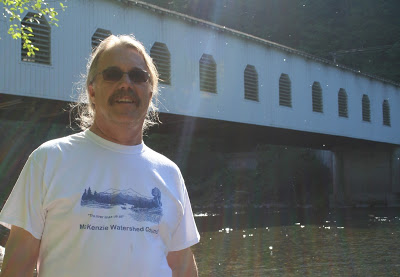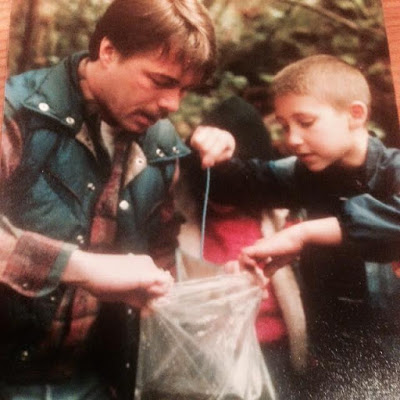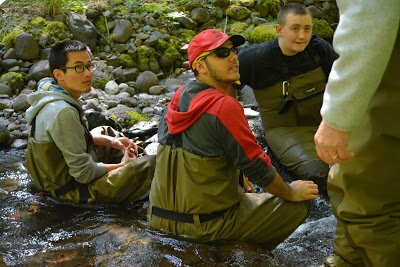When
Kurt Cox arrived in Oregon to teach, he saw that Salmon defined the Northwest
and wanted to bring that into his classroom. In 1998, at the suggestion of the
McKenzie Schools administrator, he joined the newly forming McKenzie Watershed Council in 1998, jumping
in with both feet to restore salmon habitat through education. In the last 13
years of serving as a partner in the council and a board member of the McKenzie
Watershed Alliance, Kurt has certainly done his part, including raising salmon,
doing hands-on learning projects with students in McKenzie Schools, assisting
with school Salmon Watch, doing river clean-ups, staffing the booth at events,
and leading discussions at the Salmon Celebration on riparian development and
fish migration.
Kurt Cox arrived in Oregon to teach, he saw that Salmon defined the Northwest
and wanted to bring that into his classroom. In 1998, at the suggestion of the
McKenzie Schools administrator, he joined the newly forming McKenzie Watershed Council in 1998, jumping
in with both feet to restore salmon habitat through education. In the last 13
years of serving as a partner in the council and a board member of the McKenzie
Watershed Alliance, Kurt has certainly done his part, including raising salmon,
doing hands-on learning projects with students in McKenzie Schools, assisting
with school Salmon Watch, doing river clean-ups, staffing the booth at events,
and leading discussions at the Salmon Celebration on riparian development and
fish migration.
As Kurt and I talk in his kitchen, just a stone’s throw from
the McKenzie River, he pulls out a pile of photographs of a younger Kurt
surrounded by elementary students and reminisces,
“Some of these kids I worked with are in their 30’s now. I get still get
e-mails from them in the fall asking if I’m still doing that salmon thing. This
is what they remember. No one remembers what they were doing on page 127.”
He points at a photo of a young girl with curly hair holding a dip net and
tells me, “This one is a Fisheries Biologist now.” He truly enjoys
seeing kids start to take stewardship of the place where they live. “In
stewardship”, he tells me, “you have to look forward and back at where
a place has been. In ownership, it’s mine. In stewardship, it’s not mine, it’s
ours.”
the McKenzie River, he pulls out a pile of photographs of a younger Kurt
surrounded by elementary students and reminisces,
“Some of these kids I worked with are in their 30’s now. I get still get
e-mails from them in the fall asking if I’m still doing that salmon thing. This
is what they remember. No one remembers what they were doing on page 127.”
He points at a photo of a young girl with curly hair holding a dip net and
tells me, “This one is a Fisheries Biologist now.” He truly enjoys
seeing kids start to take stewardship of the place where they live. “In
stewardship”, he tells me, “you have to look forward and back at where
a place has been. In ownership, it’s mine. In stewardship, it’s not mine, it’s
ours.”
Beyond the educational component of working with MWC, Kurt’s
favorite part is the collaboration of a dichotomy of people. Partners represent
a wide range of groups from organic agriculture to private timber companies,
fishermen, state agencies and municipalities like EWEB. Each brings a different
perspective, and different parts working together develops a more wholistic
view. In this concentrated organized effort by different people with different
mindsets to work on something, “everyone’s gotta give up a little bit”.
He enjoys the process, and says he has even enjoyed sitting down with private
timber people holding very different views.
favorite part is the collaboration of a dichotomy of people. Partners represent
a wide range of groups from organic agriculture to private timber companies,
fishermen, state agencies and municipalities like EWEB. Each brings a different
perspective, and different parts working together develops a more wholistic
view. In this concentrated organized effort by different people with different
mindsets to work on something, “everyone’s gotta give up a little bit”.
He enjoys the process, and says he has even enjoyed sitting down with private
timber people holding very different views.
In the 13 years he has served on the Watershed
Council, Kurt has seen many positive changes unfold. EWEB’s Volunteer Incentive
Program, for example, was born out of turmoil over county imposed riparian
buffers. Not only does the VIP program help people and give incentives to take
care of the water, but it helps EWEB by keeping the water lower in sediment and
cooler in temperatures, which in turn
helps fish. Kurt has also seen an expanded Salmon Watch Program, expanded
outreach in schools, more work with private land owners, an increase in bull
trout populations with the help of USFS and Army Core of Engineers, the Oregon
Chubb becoming the first de-listed endangered fish species, and an overall
changing of people’s ideas of what they can do the make rivers more productive.
He has also seen the SPARC
Program at McKenzie High School connect countless students with the
watershed and develop stewardship, and further educational developments for
post secondary students at H.J. Andrews Experimental Forest.
Council, Kurt has seen many positive changes unfold. EWEB’s Volunteer Incentive
Program, for example, was born out of turmoil over county imposed riparian
buffers. Not only does the VIP program help people and give incentives to take
care of the water, but it helps EWEB by keeping the water lower in sediment and
cooler in temperatures, which in turn
helps fish. Kurt has also seen an expanded Salmon Watch Program, expanded
outreach in schools, more work with private land owners, an increase in bull
trout populations with the help of USFS and Army Core of Engineers, the Oregon
Chubb becoming the first de-listed endangered fish species, and an overall
changing of people’s ideas of what they can do the make rivers more productive.
He has also seen the SPARC
Program at McKenzie High School connect countless students with the
watershed and develop stewardship, and further educational developments for
post secondary students at H.J. Andrews Experimental Forest.
Photo by SPARC student, Angel Botello
Looking forward, Kurt
sees the future of MWC in education. For both youths and adults, the increasing continued
awareness through education about solutions and issues and how we can be
involved locally is invaluable. Ultimately, it’s all about education, partnerships,
and working together for a common goal. Just as the McKenzie River is unique,
so are the people like Kurt, working to protect it.
sees the future of MWC in education. For both youths and adults, the increasing continued
awareness through education about solutions and issues and how we can be
involved locally is invaluable. Ultimately, it’s all about education, partnerships,
and working together for a common goal. Just as the McKenzie River is unique,
so are the people like Kurt, working to protect it.




Water is a very big deal for my family. My husband is chairman of the board of our county's soil and water conservation service and past president and vice-president of the state wide organization. Our daughter raises Atlantic salmon and I raise rainbow trout. We live in what's called a "high value watershed." Great story about Kurt! I enjoyed it very much.
Thank you! Water is one of the most important things we all have, so I am encouraged hearing stories of folks working to protect and care for our waterways.